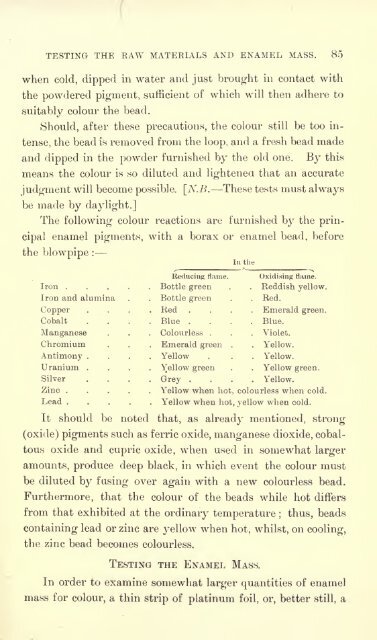Enamels and enamelling; an introduction to the preparation and ...
Enamels and enamelling; an introduction to the preparation and ...
Enamels and enamelling; an introduction to the preparation and ...
Create successful ePaper yourself
Turn your PDF publications into a flip-book with our unique Google optimized e-Paper software.
TESTING THE RAW MATERIALS AND ENAMEL MASS. 85<br />
when cold, dipped in water <strong><strong>an</strong>d</strong> just brought<br />
in contact with<br />
<strong>the</strong> powdered pigment, sufficient of which will <strong>the</strong>n adhere <strong>to</strong><br />
suitably colour <strong>the</strong> bead.<br />
Should, after <strong>the</strong>se precautions, <strong>the</strong> colour still be <strong>to</strong>o in-<br />
tense, <strong>the</strong> bead is removed from <strong>the</strong> loop, <strong><strong>an</strong>d</strong> a fresh bead made<br />
<strong><strong>an</strong>d</strong> dipped in <strong>the</strong> powder furnished by <strong>the</strong> old one. By this<br />
me<strong>an</strong>s <strong>the</strong> colour is so diluted <strong><strong>an</strong>d</strong> lightened that <strong>an</strong> accurate<br />
judgment will become possible. [N.B. These tests must always<br />
be made by daylight.]<br />
The following colour reactions are furnished by <strong>the</strong> prin-<br />
cipal enamel pigments,<br />
<strong>the</strong> blowpipe :<br />
Iron ..... Bottle<br />
with a borax or enamel bead, before<br />
In <strong>the</strong><br />
Reducing flame. Oxidising flarne.<br />
green . . Reddish yellow.<br />
Iron <strong><strong>an</strong>d</strong> alumina . . Bottle green . . Red.<br />
Copper . . . . Red .... Emerald green.<br />
Cobalt .... Blue .... Blue.<br />
M<strong>an</strong>g<strong>an</strong>ese . . . Colourless . . . Violet.<br />
Chromium . . . Emerald green . . Yellow.<br />
Antimony .... Yellow . . . Yellow.<br />
Ur<strong>an</strong>ium .... Yellow . . green Yellow green.<br />
Silver .... Grey .... Yellow.<br />
Zinc Yellow when hot, colourless when cold.<br />
Lead Yellow when hot, yellow when cold.<br />
It should be noted that, .as already mentioned, strong<br />
(oxide) pigments such as ferric oxide, m<strong>an</strong>g<strong>an</strong>ese dioxide, cobal-<br />
<strong>to</strong>us oxide <strong><strong>an</strong>d</strong> cupric oxide, when used in somewhat larger<br />
amounts, produce deep black, in which event <strong>the</strong> colour must<br />
be diluted by fusing over again with a new colourless bead.<br />
Fur<strong>the</strong>rmore, that <strong>the</strong> colour of <strong>the</strong> beads while hot differs<br />
from that exhibited at <strong>the</strong> ordinary temperature ; thus, beads<br />
containing lead or zinc are yellow when hot, whilst, on cooling,<br />
<strong>the</strong> zinc bead becomes colourless.<br />
TESTING THE ENAMEL MASS.<br />
In order <strong>to</strong> examine somewhat larger qu<strong>an</strong>tities of enamel<br />
mass for colour, a thin strip of platinum foil, or, better still, a
















